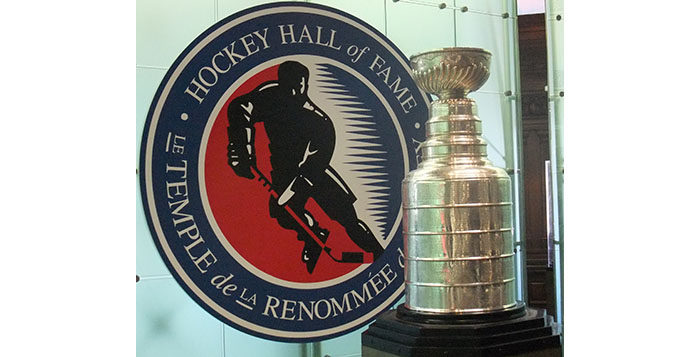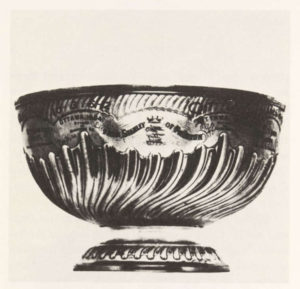This Day in Hockey History – April 6, 1926 – Buh-bye Challenger
(Photo: mark.watmough from Toronto, Canada / CC BY)
In today’s sport of hockey in North America, the National Hockey League is considered the penultimate achievement for a hockey player, and as a professional hockey player playing for the NHL, the Stanley Cup is the ultimate prize. In more recent years the regular season ends the first weekend in April and then the playoff season begins, culminating in the Stanley Cup Final in June. Pretty much everyone alive today has only seen the Stanley Cup hoisted by an NHL team, but such was not always the case.
The original Stanley Cup was actually what is referred to as a rose bowl, and Lord Stanley saw how he wanted the teams to play for it, even into the future with his constitution, or rules, that his appointed Cup trustees should follow. Of course, at the time of its inception, Lord Stanley did not view any team outside of Canada as being a possible challenger for the Cup. The first Cup was awarded in 1893 to the Montreal Hockey Club.
The trustees outlined a system by which the first-place team of another Canadian hockey association could “challenge” for the Cup. Unlike today’s playoff season, the Cup was awarded to the “team that wins the title of the previous Cup champion’s league.” However the first place team in another Canadian hockey association could then contact the trustees indicating their desire to challenge for the Cup. The first official Cup challenge came in 1895 from Queen’s University, who unfortunately fell to the Montreal Hockey Club (the previous year’s Stanley Cup Champion), however the Cup was awarded to the Montreal Victorias who had been the leading team in the Amateur Hockey Association of Canada that year. The following year saw the first challenge in which the Cup went to the challenger, the Winnipeg Victorias of the Manitoba Hockey League.
In 1922, with the addition of the Western Canada Hockey League, the National Hockey League (formed in 1917) and the Pacific Coast Hockey Association (formed in 1911) and the WCHL competed for the Cup. The two league champions faced each other, and winner of that competition had the right to challenge the third league’s champion in the final. In 1925 the WCHL and the PCHA merged to form the Western Hockey League.
The Victoria Cougars of the WHL, who were the Stanley Cup champions in 1925 took on the Montreal Maroons of the NHL in a best-of-five series to crown the new champion in 1926. What turned out to be the final game of that series was played on April 6, 1926.
The series had begun March 30, 1926 at the Montreal Forum, a game played under NHL rules.
“Fresh from a brilliant triumph in winning the National Hockey League title, the Montreal Maroons started a promising rush towards the Stanley Cup and world’s professional hockey honors, when they blanked the Victoria Cougars, 3-0 in the first game of the major series before a crowd of 10,250 at the Forum last night.”
During the second game, the Maroons had once again shutout the Cougars 3-0, despite playing under western rules. Going into the fourth game of the series, the Montreal Maroons carried a 2-1 lead in games won over the Victoria Cougars, having fallen in the third game 3-2. The fourth game, like the second, was to be played according to the WHL rules, and some weren’t sure that the Maroons could pull out a second win under those rules.
“It was a magnificent night for the loyal fans who have supported the Maroons throughout their sensational climb to the peak of hockey fame. They packed the rink for the fourth consecutive time to witness what proved the deciding game of the cup series. They were treated to a fast display—even though the game under western code appeared to many to lack the real, methodical and inside hockey which characterizes the code prevailing in the National Hockey League.”
For Maroons’ goaltender Clint Benedict, it was his third shutout in the series. Meanwhile, Nels Stewart, who scored both goals in the final game on April 6, had a total of six goals in the series (2 in Game 1, 1 in Game 2, 1 in Game 3, and 2 in Game 4) both starting out with two and ending with two.
For Stewart, in his first season as a professional hockey player, it turned out that it wasn’t just his “calculating, crafty hockey,” that proved invaluable to his two goals scored in the second period of the fourth game, but a bit of superstitious luck in his stick.
“After the Ottawa game a Maroon supporter claimed Nelson Stewart’s stick as a souvenir of the first N.H.L. title captured by the club. After the defeat Saturday night in the third cup game, Stewart telephoned the Maroon supporter and asked to have his pet stick returned for last night’s contest, stating that he was out to play the game of his career and that he would feel more at home with his ‘old trusty.’ The stick was turned over at the dressing room before the game. It was the means by which the ‘million dollar’ goals were scored. And after the game it was returned to the fan, who now has a souvenir to be doubly cherished.”
With the 2-0 shutout and the third winning game of the series going to the Montreal Maroons, the Cup was claimed and taken back to Montreal.
No one actually knew that this would be the end of an era. The WHL folded in 1926 and when it did the NHL picked up the best players of this western league, such that the Prairie Hockey League that replaced the WHL was not consider a major league. As a minor league, the result of not having an ability to get the best players, it was not allowed to challenge for the Cup.
With their win on April 6, 1926, the Montreal Maroons saw the last Stanley Cup playoff to feature a team that was not part of the National Hockey League. It wasn’t until 1947 though that the NHL would be granted control of the Cup by its trustee J. Cooper Smeaton. Among other things in the agreement with the NHL, the trustees agreed that for as long as the agreement is in place, that the NHL would have the authority in identifying the qualifications of a challenger and that the trustees would not accept any challengers other than those identified by the said qualifications dictated by the NHL.
Additional Sources:
- “Montreal Blanked Victoria, 3-0, in First Cup Battle,” The Gazette (Montreal, Quebec), Wednesday, March 31, 1926, p. 18.
- “Montreal Blancked Victoria, 3-0, in Second Cup Game,” The Gazette (Montreal, Quebec), Friday, April 2, 1926, p. 16.
- “Montreal Cracked and Victoria Took Third Battle, 3-2,” The Gazette (Montreal, Quebec), Monday, April 5, 1926, p. 16.
- “Fourth Cup Game Billed for Forum Tomorrow Night,” The Gazette (Montreal, Quebec), Monday, April 5, 1926, p. 16.
- Andrew Podnieks, Lord Stanley’s Cup (Bolton, Ontario: Fenn Publishing Company Ltd., 2004), p. 3-4.















